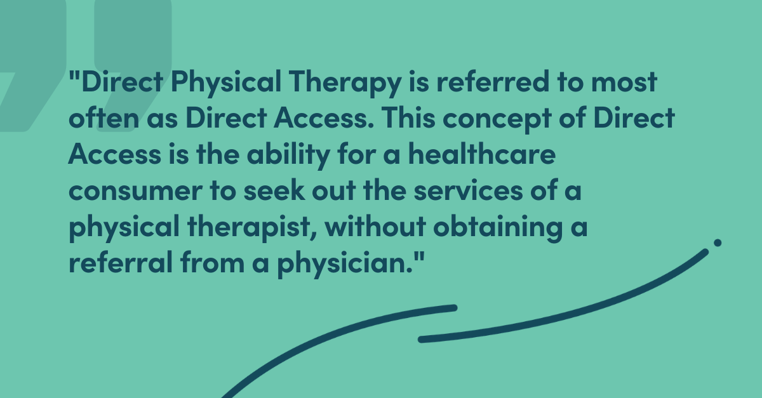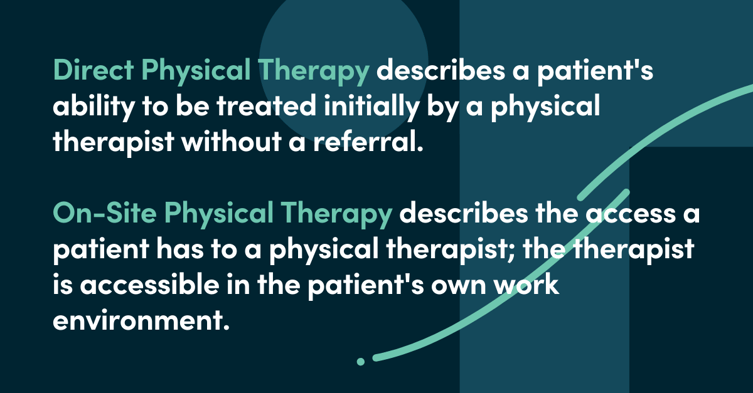Over the course of the past few months, I’ve been a part of many conversations about the differences between Direct Physical Therapy and On-Site Physical Therapy. After some thought, it occurred to me that there are many differences but also several similarities that are noteworthy. In this article, I’m looking forward to defining each term so we can all better understand the healthcare deficits that these methods address. Ready to get your white coat?
What Is Direct Physical Therapy?

Within the United States, the ability to provide physical therapy services is a state governed issue by way of “state-practice acts”. This legislation has maintained for decades that physical therapy services must be ordered by physicians but, in recent years, the American Association of Physical Therapy has successfully lobbied for direct access for patients.
As a result, many states began adjusting the practice act and recognizing that physical therapists are licensed healthcare professionals that are highly capable of providing initial management of musculoskeletal dysfunctions. In plain English, this simply means there’s no one standing in the way of a patient seeing the physical therapist of their choice to solve their aches and pains.
Direct Physical Therapy is referred to most often as Direct Access. This concept of Direct Access is the ability for a healthcare consumer to seek out the services of a physical therapist, without obtaining a referral from a physician.
Direct Physical Therapy, or Direct Access, is still evolving. This means that some commercial insurance carriers may still require a physician referral to a physical therapist in order to process the cost of care through insurance.
Though the trend is moving towards carriers covering services provided under direct access, many physical therapists are electing to operate in “cash-pay only” establishments. This way, the therapist isn’t restricted in what they can do to treat a patient’s ailments based solely on what the patient’s insurance will or will not cover.
The efficacy and value of Direct Physical Therapy has been validated through scientific research that shows it’s safe, effective, and more affordable than pursuing a physician referral.
What Is On-Site Physical Therapy?
On-Site Physical Therapy can be confused with Direct Physical Therapy, but it is quite different.
“On-Site Physical Therapy is just what it says: it is the provision of physical therapy where the patients are.”
Physical therapists work in many on-site locations ranging from traveling performance tours, cruise ships, universities, and most commonly, at industrial sites. When you think of a physical therapist, you may tend to imagine them in a hospital or outpatient clinic treating patients that come to them.
Increasingly, it is becoming more popular for physical therapists to place themselves in the environment of the patient. And why not? From a physical therapist’s point of view, why should I sit in my “office” and wait for someone to magically appear in my doorway? Would it not make more sense to go where the patients are?
From the patient's point of view, it is vastly more convenient to have access to a physical therapist in the same location where they spend half of their day. Physical therapists are beginning to team up with employers to provide access to immediate musculoskeletal evaluation and treatment in order to create a much more efficient pathway to injury mitigation.

The 3 C’s of Similarity
The similarities between these two descriptions of care are as follows:
Convenience
It is much more convenient to be able to go to the on-site physical therapist. Employees won’t need to schedule an appointment with a non-essential healthcare provider just to get them through the correct door. What’s more, with an on-site physical therapist, the employee is able to access the correct provider at their place of employment. The time saved in both scenarios is extremely valuable and encourages more proactive utilization.
Cost Savings
For employees and employers, the savings come in many forms. Being able to avoid unnecessary testing saves real dollars. Both Direct Physical Therapy and On-Site Physical Therapy save considerable costs by avoiding lost production time.
Direct Physical Therapy allows you to avoid lost time and the added costs associated with going through a primary care physician for a referral to a physical therapist. When the company is able to access the skills of a physical therapist to immediately triage and treat on-site injuries, it can result in massive cost savings.
These efforts can drive down recordable injuries and return patients back to work more rapidly. All of these reduce, not only the current medical costs but the ongoing increases in workers compensation premiums that come with high total recordable incident rates (TRIR) and high days away restricted rates (DART).
Check out our ROI Calculator to see how your company stacks up to the competition in your industry and how much you could save with an onsite physical therapist.
Correct Provider
In a previous blog, I referenced the overwhelming statistics that show how most human beings struggle with some form of musculoskeletal dysfunction (MSK). These MSK result in the leading cause of disability in the world according to the World Health Organization. The experts in the evaluation and treatment of MSK are the physical therapists. The more accessible they are, the earlier interventions can be applied, and the more rapidly they can be resolved. There is simply no need for primary care physicians, much less urgent care or emergency room physicians, to be bogged down with patients that can and should be seen directly by a physical therapist.
What are DPT and OSPT and What are They Not?
Direct Physical Therapy (DPT) does not mean that the therapist is more accessible. It does remove the need for a visit to a primary care physician or specialist, but most physical therapists are still located in brick and mortar clinics that require travel from the place of employment.
In contrast, On-Site Physical Therapy (OSPT) does not always equate to Direct Access without a referral. Depending on the type of health insurance provided by the employer, the employee may still need a referral to utilize On-Site Physical Therapy.
As I mentioned earlier, Direct Access and its existing limitations by commercial insurance carriers has caused some physical therapists to operate in “cash-pay only” establishments, and forward-thinking employers have begun to follow suit. Many employers have sought out self-funded health insurance plans in order to have more control over the care their employees receive.
“By using self-funded strategies, an employer can allow direct access to a physical therapist without the need for unnecessary providers to be involved.”
A Message To Employers: Combine the Benefits of Both in Your Workplace
My father-in-law Gary is a mechanic by trade. When it comes to fixing anything that runs on wheels, he is an expert. Not long ago my truck was running poorly. I called Gary and asked what I should do. He offered a quick solution that involved using a diagnostic code reader. You turn the reader on and with a couple of clicks, the reader tells you exactly what is wrong with your car. In my case, I had a bad spark plug—something really simple to fix myself. Without Gary being readily accessible to me, I would have had to schedule an appointment at the local dealership and hope that I could afford the suggested repairs. As it turned out, I fixed my issue in about an hour, in my own garage, for less than $4!
Similarly, having unfettered access to a physical therapist is tremendous. If you are an employer and you’re having a difficult time mitigating workplace injuries and the associated costs, I would like to offer a suggestion — would you consider combining the benefits of Direct Physical Therapy with On-Site Physical Therapy?
Over To You
-
If you currently are using a commercial carrier for health insurance coverage, start by researching the benefits of being self-funded. This would allow you more control over how your health benefits are managed. It would allow you to utilize the expertise of a physical therapist without being forced to use urgent care or emergent care physicians as gatekeepers for your manageable musculoskeletal injuries.
-
Consider using an On-Site Physical Therapist in conjunction with your self-funded freedom to provide instant access to their expertise. Their ability to reduce recordable injuries through proper triage and use of first aid treatments will show an immediate return on investment.
-
The ability for your employees to access musculoskeletal dysfunction experts at their place of employment will result in increased employee engagement and a healthier and more productive workforce. Having direct physical therapy on-site is a win for everyone.
If you would like to know how you can unleash the power of these two concepts in your company, schedule an assessment today.
We created Therady to bring the power of these two concepts together and change the way we access and utilize healthcare. Talk to us today to find out how Therady can move your company into the future of healthcare management.





